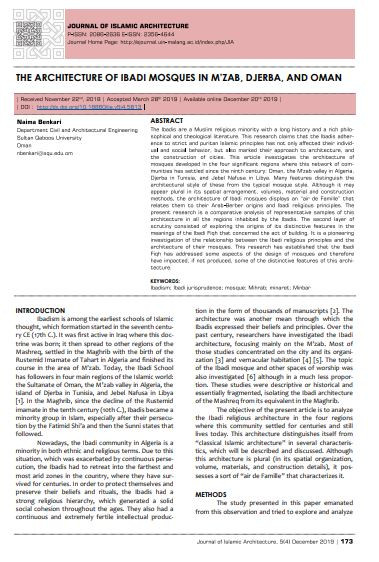
The Ibadis are a Muslim religious minority with a long history and a rich philosophical and theological literature. This research claims that the Ibadis adherence to strict and puritan Islamic principles has not only affected their individual and social behavior, but also marked their approach to architecture, and the construction of cities. This article investigates the architecture of mosques developed in the four significant regions where this network of communities has settled since the ninth century: Oman, the M’zab valley in Algeria, Djerba in Tunisia, and Jebel Nafusa in Libya. Many features distinguish the architectural style of these from the typical mosque style. Although it may appear plural in its spatial arrangement, volumes, material and construction methods, the architecture of Ibadi mosques displays an “air de Famille” that relates them to their Arab-Berber origins and Ibadi religious principles. The present research is a comparative analysis of representative samples of this architecture in all the regions inhabited by the Ibadis. The second layer of scrutiny consisted of exploring the origins of its distinctive features in the meanings of the Ibadi Fiqh that concerned the act of building. It is a pioneering investigation of the relationship between the Ibadi religious principles and the architecture of their mosques. This research has established that the Ibadi Fiqh has addressed some aspects of the design of mosques and therefore have impacted, if not produced, some of the distinctive features of this architecture.
I agree to the terms outlined below:
You agree to upload and assign Mosqpedia Database the rights to use the content worldwide and in perpetuity across all current and future media platforms. Mosqpedia Database may edit, copy, adapt and translate your contribution.
The content will be distributed under the Creative Commons Attribution-Deed – Attribution-NonCommercial-NoDerivatives 4.0 International – Creative Commons
All data will be stored in line with data protection regulations.